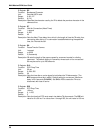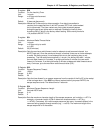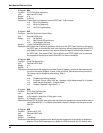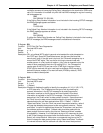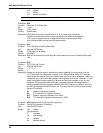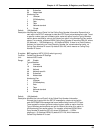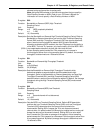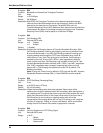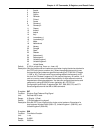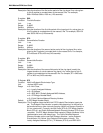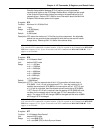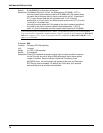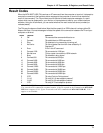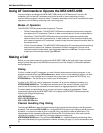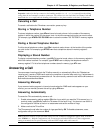
66
MultiModemISDN User Guide
S-register: S63
Function: Bandwidth-on-Demand Low Throughput Threshold
Unit: Kbps
Range: n=0–64 (Kbps)
Default: 26 (26 Kbps)
Description:Sets BOD Low Throughput Threshold, which determines whether second
channel should be disconnected due to low throughput. Refer to the BOD
description and how the Low Throughput Threshold (S63) and Low
Threshold Sampling Period (S62) determine when second channel should be
disconnected. By default, the average throughput during the Low Threshold
Sampling Period (S62) must be equal to or less than 26 Kbps.
S-register: S64
Function: Call Bumping (CB)
Unit: Decimal ASCII code
Range: n=0 Disable
n=1 Enable
Default: 1 (Enable)
Description:Enables the Call Bumping feature of Dynamic Bandwidth Allocation. With
Call Bumping disabled, incoming and outgoing calls are not possible if both
B-channels are already in use. With Call Bumping enabled, incoming and
outgoing analog calls through the POTS port are possible even if both B-
channels are in use. If the TA is acting as a host device, Call Bumping is
available to the host TA only if MP+ (S59=1) was negotiated by both the
client and the host. Also, Call Bumping is not available to the host TA if the
Dynamic Bandwidth Allocation scheme is MP+ (S59=1) and MP+ negotiation
fails. If MP+ negotiation was successful (meaning both client and host
support MP+), Call Bumping is available to the host TA. By default, Call
Bumping is enabled.
Note: If using the TA as a host for MultiLink PPP calls with the MP+ Dynamic
Bandwidth Allocation scheme (S59=1), Data DN/MSN 2 must be entered.
S-register: S65
Function: POTS Call Bump Forwarding Delay
Unit: 5 ms
Range: n=0-255 (0 ms to 1275 ms)
Default: 20 (100 ms delay)
Description:Allows the forwarding delay time to be adjusted. Some central office
switches are not able to accept another call immediately after tearing down a
call (meaning the TA is able to tear down a call and initiate another call much
faster than the central office). If the central office switch is too slow, then a
Call Bump (due to an incoming or outgoing analog call) will not be
recognized and the analog device will not ring (if incoming) or will not give a
dial tone (if outgoing). A delay of 100 ms is the default, which should allow
enough time for the central office switch to prepare for new calls.
S-register: S66
Function: Country Selections for POTS Ring Signal
Unit: Decimal ASCII code
Range: n=0–27
0 Default
1 Custom single
2 Custom dual



